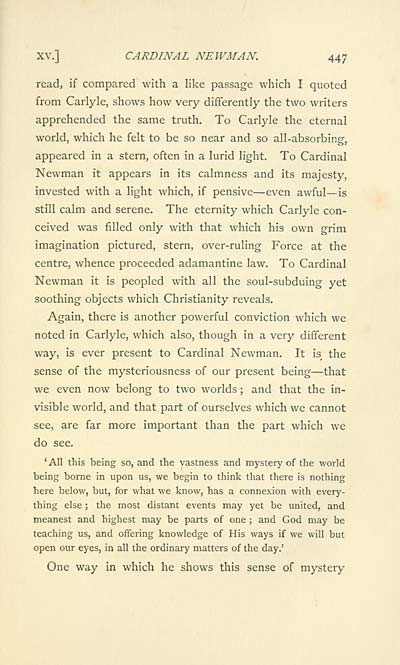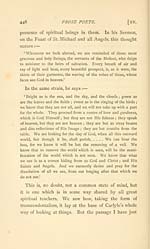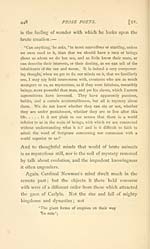Ossian Collection > Aspects of poetry
(463)
Download files
Complete book:
Individual page:
Thumbnail gallery: Grid view | List view

XV.] CARDINAL NEWMAN. 447
read, if compared with a like passage which I quoted
from Carlyle, shows how very differently the two writers
apprehended the same truth. To Carlyle the eternal
world, which he felt to be so near and so all-absorbing,
appeared in a stern, often in a lurid light. To Cardinal
Newman it appears in its calmness and its majesty,
invested with a light which, if pensive — even awful— is
still calm and serene. The eternity which Carlyle con-
ceived was filled only with that which his own grim
imagination pictured, stern, over-ruling Force at the
centre, whence proceeded adamantine law. To Cardinal
Newman it is peopled with all the soul-subduing yet
soothing objects which Christianity reveals.
Again, there is another powerful conviction which we
noted in Carlyle, which also, though in a very different
way, is ever present to Cardinal Newman. It is the
sense of the mysteriousness of our present being — that
we even now belong to two worlds ; and that the in-
visible world, and that part of ourselves which we cannot
see, are far more important than the part which we
do see.
'All this being so, and the vastness and mystery of the world
being borne in upon us, we begin to think that there is nothing
here below, but, for what we know, has a connexion with every-
thing else ; the most distant events may yet be united, and
meanest and highest may be parts of one ; and God may be
teaching us, and offering knowledge of His ways if we will but
open our eyes, in all the ordinary matters of the day,'
One way in which he shows this sense of mystery
read, if compared with a like passage which I quoted
from Carlyle, shows how very differently the two writers
apprehended the same truth. To Carlyle the eternal
world, which he felt to be so near and so all-absorbing,
appeared in a stern, often in a lurid light. To Cardinal
Newman it appears in its calmness and its majesty,
invested with a light which, if pensive — even awful— is
still calm and serene. The eternity which Carlyle con-
ceived was filled only with that which his own grim
imagination pictured, stern, over-ruling Force at the
centre, whence proceeded adamantine law. To Cardinal
Newman it is peopled with all the soul-subduing yet
soothing objects which Christianity reveals.
Again, there is another powerful conviction which we
noted in Carlyle, which also, though in a very different
way, is ever present to Cardinal Newman. It is the
sense of the mysteriousness of our present being — that
we even now belong to two worlds ; and that the in-
visible world, and that part of ourselves which we cannot
see, are far more important than the part which we
do see.
'All this being so, and the vastness and mystery of the world
being borne in upon us, we begin to think that there is nothing
here below, but, for what we know, has a connexion with every-
thing else ; the most distant events may yet be united, and
meanest and highest may be parts of one ; and God may be
teaching us, and offering knowledge of His ways if we will but
open our eyes, in all the ordinary matters of the day,'
One way in which he shows this sense of mystery
Set display mode to: Large image | Transcription
Images and transcriptions on this page, including medium image downloads, may be used under the Creative Commons Attribution 4.0 International Licence unless otherwise stated. ![]()
| Early Gaelic Book Collections > Ossian Collection > Aspects of poetry > (463) |
|---|
| Permanent URL | https://digital.nls.uk/78390828 |
|---|
| Description | Selected books from the Ossian Collection of 327 volumes, originally assembled by J. Norman Methven of Perth. Different editions and translations of James MacPherson's epic poem 'Ossian', some with a map of the 'Kingdom of Connor'. Also secondary material relating to Ossianic poetry and the Ossian controversy. |
|---|
| Description | Selected items from five 'Special and Named Printed Collections'. Includes books in Gaelic and other Celtic languages, works about the Gaels, their languages, literature, culture and history. |
|---|

